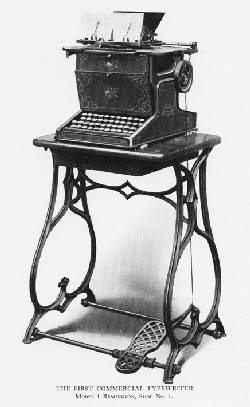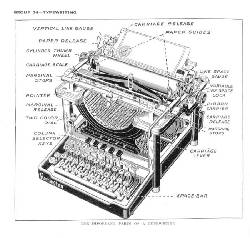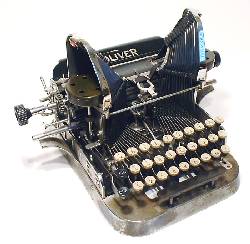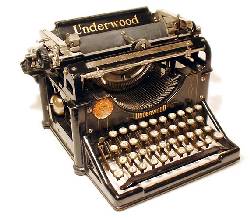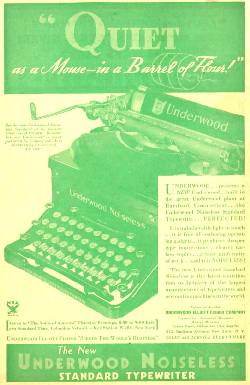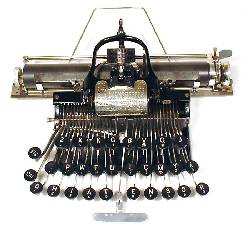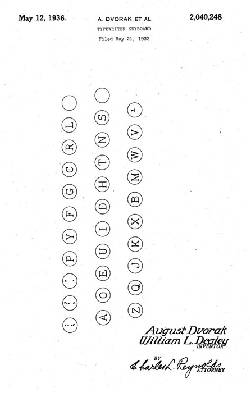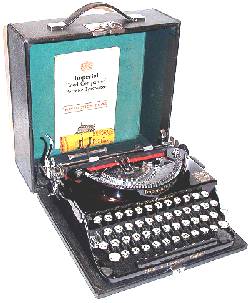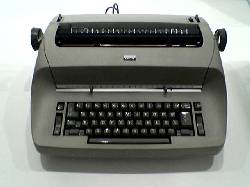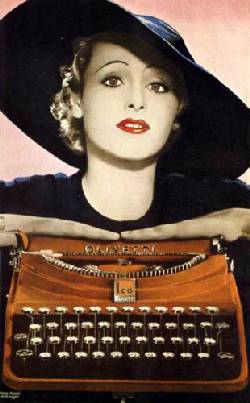The User-friendly Typewriter
Martin Campbell-Kelly
Introduction
“User friendliness” has, for 20 to 30 years, been a major sub-discipline of computer science.1 The discipline usually goes under the name of human-computer interaction (HCI) studies, although up to the early 1980s “man” was often used instead of “human.”2 Researchers and practitioners have several learned journals, mostly founded in the 1980s, and professional societies such as the Association of Computing Machinery’s Special Interest Group on Computer-Human Interaction (ACM SIGCHI) founded in 1982.
Ease-of-use in product design is, however, a concern that long predates the widespread use of digital computers in the 1970s and 1980s. Many HCI practitioners and textbook writers are conscious of this heritage and often pay homage to it—the development of the QWERTY keyboard perhaps being the most popular example. However, it must be said that historical examples cited by practitioners are sometimes misunderstood or exaggerated. This is not a criticism of laudable attempts to contextualize modern usability studies; it is simply that there are very few reliable sources.3
Although most HCI practitioners could be accused of appropriating usability with scant regard for pioneers in fields as diverse as medicine, acoustics, and aerospace, they have in fact brought a maturity to the field in terms of systematic study and defining its shape and boundaries. The reason that this never happened before was that ease-of-use was implicit, and merely one aspect of product design. If one looks at the histories of information technologies such as typewriters, radio sets, cameras, or telephones, for example, it is clear that usability was always a major concern, but only one of many conflicting design objectives that had to be negotiated. HCI studies probably owes its existence as a focussed discipline to the economic significance and particular complexity of the computer field.
It is often said that historians write for their own generation. In the case of the present article, it is the present-day interest in usability that seems to make an historical study of the ease-of-use of early technologies timely. In this paper I will therefore attempt to use the methodology of the historian within the analytical framework of modern usability studies to examine the evolution of the typewriter from an historical perspective.
A typical modern usability framework focuses on three high-level issues:
- Cognition—will the user understand, learn, and be able to operate the artifact?
- Ergonomic—will the user be able to operate the artifact efficiently and safely?
- Emotion—will the user want to use the artifact?
These high-level issues decompose into a large number of low-level concerns. For example, the most important cognitive issue with the typewriter was the “visibility” of typing, because on early models it was not possible for the operator to see what was being typed as it was being typed, and this made excessively high demands on the short-term memory. A major ergonomic issue was the lightness and evenness of the keyboard, so that a moderate but variable force on the keys would produce legible print of constant blackness. One of the emotional concerns of early typewriters was the acceptability to recipients of typed letters. For some individuals a typed letter was perceived as a presumption that they could not read ordinary handwriting, and they were offended by the slur on their learning.4
There is no neat taxonomy of usability, however, and some issues cut across the cognitive, ergonomic and emotion domains. For example, portable typewriters addressed the ergonomic issue of physically carrying a typewriter on assignment, but were sold through the emotional appeal of modernism (Fig. 1); and they gave rise to a set of cognitive issues of how a complex machine could be learned without any formal instruction.
In this paper I will not attempt to create an orderly taxonomic tree of typewriter usability defects; for one thing, that is not how the typewriter evolved. Instead I will try to explain the historical evolution of the typewriter as the timely solution to the most pressing but tractable usability defects.
Prehistory
The first commercially successful typewriter was the Remington No. 1, first sold in 1874. This was, in fact, about the fiftieth writing machine to be invented, but it was the first to achieve commercial success because it solved both of the critical problems in writing machine design—the legibility of typescript and the speed of operation.
Prior to the invention of the typewriter, clerks who managed the commercial correspondence of an organization learned shorthand and penmanship; and less well trained, less well paid clerks would make fair copies of documents as needed. In large offices, particularly in the UK, “writers”—also known as “scriveners” or “copyists”—were employed in large numbers in the second half of the nineteenth century. This labour force typically consisted of young boys and girls fresh out of elementary school, and was correspondingly inexpensive.5 Copyists worked quickly, but however neatly they wrote, reading Victorian copperplate was time consuming and required concentration. Where legibility was paramount, the services of a printer were used and it was common to typeset important communications. However, typesetting was very expensive and was no threat to the copyist’s occupation. The need for typewriters arose as much from the desire to save manager’s reading time as to reduce the labour cost of longhand copying. While some early writing machines produced acceptable copy, they were much slower than the 25 words per minute of an experienced copyist.6
The Remington typewriter was the first machine to combine acceptable print quality with acceptable speed. The machine was invented by Christopher Latham Sholes, a retired printer in Milwaukee, Wisconsin, who was inspired by an article on writing machines he read in the Scientific American in 1867. 7 Sholes took out patents on his invention, and in exchange for a quarter share of these he obtained what we would now call angel funding from James Densmore, a prosperous retired printer. It is said that Sholes produced dozens of prototypes before achieving a satisfactory design. Densmore did not have sufficient funds to manufacture the machines, however, so he negotiated with Philo Remington, an Ilion, New York, manufacturer of small arms, to make them. Remington accepted the offer because his business was in the doldrums following the end of the Civil War and he had already diversified into peacetime manufactures, including sewing machines. More development work followed and the Remington No. 1 was introduced in 1874—its visual design owing not a little to the sewing machine (Fig. 2).8
Thereafter, product evolution was continuous, with the frequent introduction of new models. Fig. 3 shows the Remington No. 10 of 1907, some 33 years after the appearance of the No. 1. As suggested by the labelling of Fig. 3, there were dozens of incremental improvements to the typewriter during that time—such as the provision of upper and lower case (the No. 1 printed capital letters only), marginal stops to prevent the typist running past the end of a line, two-colour ribbons, a paper bail to hold the paper firmly against the platen, a carriage lever for rapid line advance, tabulator keys for easy column alignment when typing tables, and so on. Some of these were Remington’s innovations; others were adopted from its competitors.
Most of these improvements were registered in the 2600 typewriter patents that had been issued by 1905.9 Unfortunately there is no history of typewriter patents, so we do not know in detail how patent pools operated. However, a great deal of patent sharing between manufacturers clearly took place, which is why all typewriters came to look and feel pretty much the same. Most patents protected features that directly or indirectly affected usability. Many innovations may have appeared to be mere tweaks—such as the bell that warned the operator that the end of line was approaching—but their impact on usability could be profound. It was the accretion of scores of tiny improvements that made the typewriter so superbly suited to its task. It is not possible in this paper to describe all of the usability innovations. Instead I will focus on a handful of major issues:
- Visibility—the need for the operator to see what was being printed;
- Noise—the importance of aural feedback;
- Keyboard layout—was QWERTY really so bad?
- User training—how people learned to type, and type faster;
- Desirability—how typing was made into a socially desirable activity.
Visual Feedback: The Search for a “Visible” Typewriter
The original Remington No. 1 was known as an “up strike” model, because the type bars struck the underside of the carriage. This meant that the line being typed was out of sight of the user, and in fact did not emerge until a further four lines had been typed. This would have made insuperable demands on the operator’s memory, and it was therefore possible to lift the carriage so that the operator could peek at the work in progress. It is not known whether Sholes was conscious of the visibility problem when he designed the up-strike mechanism. It seems likely that he just opted for the mechanically simplest solution. At all events, this design deficiency left the door open for dozens of non-patent-infringing improvements (most of which vanished into obscurity).
For an operator seated at a desk, the optimal printing position was a front strike mechanism, so that the printed line directly faced the operator. The first machine on the market with a front-strike mechanism was the Columbia Bar-Lock, patented in 1889-91.10 The first commercial models enabled the operator to peer above the type bars to see the work in progress, but the line of sight was obscured if the operator sat too far back in his or her chair. Nonetheless, for several years the Columbia Bar-Lock “stood alone in the visible writing field.”11 A wholly satisfactory front strike mechanism that did not interfere with the line of sight was extremely difficult to achieve, and would not be realised until the Underwood No. 1 came into production in 1897. In the interim, a number of down-strike models, which printed on top of the carriage, were produced.
One of the first down-strike machines was the Williams No. 1 of 1892. This used the “grasshopper mechanism” invented by John N. Williams.12 In this machine the type bars were held horizontally, sprang out, struck the top of the carriage, and instantly retracted, leaving the line of typing visible. Only the current line was visible, however, because the previous lines were rolled back into the carriage. It was only a marginal improvement over up-strike designs.
A much more successful down-strike mechanism was designed by the Reverend Thomas Oliver, who applied for a patent in 1892 and founded the Oliver Typewriter Company of Chicago in 1894.13 In this very distinctive machine the inverted-U shaped type bars were stacked either side of the printing point (Fig. 4). This left the full page clearly visible, a marked improvement over previous designs. The Oliver machine was particularly robust and was bought in large numbers by the military, although it did have the disadvantage of a rather restricted character set. (It was difficult to stack many more than a dozen type-bars on top of one another. The machine had a three-row keyboard instead of the usual four rows. The basic design remained in production with very little major modification until the 1940s.14
Nonetheless the front-strike mechanism remained the best ergonomic design for a seated operator. A successful design was finally produced, some 15 years after the first front-strike models appeared, by the inventor Francis X. Wagner. It was the most important typewriter patent of all time.15 The patent was assigned to a New York typewriter-supplies manufacturer John Underwood, and the Underwood Typewriter Company was established for its manufacture in 1895. With the Underwood No. 1 (Fig. 5) the typewriter took its modern form, establishing the dominant typewriter design until the advent of the IBM golf ball typewriter after the Second World War. In the Wagner design, the type basket was set low, out of the line of sight, and the ribbon did not obscure the current line. When a key was depressed, the ribbon rose and interposed between the type bar and the paper; both then instantly retracted to their original position to reveal the full line of print. It was an extraordinarily elegant mechanism. The Underwood No. 1 went on the market in 1897 and was rapidly further perfected.
The Underwood’s success was not, however, only due to its visibility. The striking mechanism used an accelerated type bar so it was not necessary to stab at the key as with other models, but to press it gently like an organ or piano key. This gave very light touch, superior to every other machine on the market. It was probably the combination of visibility and lightness of touch that gave the Underwood its compelling advantages. The fully perfected Underwood No. 5 was a best seller from the moment it was launched in 1900. Two million machines had been sold by the early 1920s, and its sales “were equal in quantity to all of the other firms in the typewriter industry combined”.16
It is worth noting, however, that many individuals resisted visible typewriters. Rather in the way that automobile drivers who had become adept at gear changing resisted automatic transmission, and expert MS-DOS users resisted the Windows graphical user interface, so there were non-visible typewriter diehards. One of the market leaders, the L.C. Smith Bros. Company, went to considerable lengths to change the culture in the early 1900s:
At that time a battle was raging in the typewriter world between those who believed in the “writing in sight” principle and those who favored the old “blind” idea. The Smith Brothers had a number of signs made for the outside of their building, which adjoined the New York Central railroad tracks. Some of these signs read as follows: “You are Right Side Up; Why Write Upside Down?” “When Precedent and Progress clash, we forsake Precedent” “Writing in Sight is in line with Progress.” There were eighteen of these signs altogether and they made a great impression upon the passengers of the New York Central who saw them. When the Smith Brothers threw their hat into the ring for the visible principle, it seemed to settle the discussion and now [1923] all manufacturers of typewriters recognize the principle of visibility.17
Visibility was one form of feedback; sound was another.
Auditory Feedback: The Riddle of the Disappearing Noiseless Typewriter
The typewriter introduced a significant degree of noise in the Victorian and Edwardian office. Before the typewriter era, there was little or no machinery in the typical office—a room full of copyists was a bustling place to be sure, but it had nothing like the level of noise of a typing pool which “might well have provided a satisfactory soundtrack to a First World War movie.”18
Early typewriters were much noisier than later, perfected models. They were substantial and over engineered: long type bars designed for maximum momentum slammed onto the platen; the manual carriage return caused the intermittent crashing of metal into metal; and worn, sloppy mechanisms produced a constant level of background noise.
The most important way of reducing noise was to eliminate the percussive action of the type bars on the platen. In 1894 an inventor, Wellington Kidder, applied for a patent for a printing action that pushed the type bar onto the platen rather than striking it.19 Kidder and his partner C.C. Colby formed a development company and “expended about $500,000 in developing the Noiseless typewriter, during the years 1904-1909.”20 The Noiseless Typewriter Company was established and a machine was placed on the market in 1910; besides the non-percussive printing action it was fully enclosed and surmounted by an acoustic cowl, characteristic of all subsequent noiseless typewriters. The machine was not a commercial success, probably because the typing mechanism was rather sluggish. Several improved machines were placed on the market, but it was only with the model 4 in 1917 that definite technical and commercial success was realised.
Given the long, costly, patented development of the noiseless typewriter, competitors could only respond with hoods and baffles. Underwood produced a soundproof cabinet in 1922, as did Continental, Ideal, and Olympia.21 In 1923 Remington introduced a quiet version of its model 12, marketed as the Q12, which reduced noise by means of a completely enclosed frame.22
In 1924 Remington acquired the Noiseless Typewriter Company (one of a series of mergers that resulted in the formation of the Remington Rand conglomerate in 1927).23 Remington sold the machine as the Remington Noiseless, and gradually refined the technology by incorporating innovations from its mainstream products. Underwood made a patent deal with Remington to acquire the noiseless technology, and then introduced a noiseless version of its standard machine in 1930. Underwood advertised the machine extensively, promoting its “cushioned typing” with the slogan “Quiet as a Mouse—in a Barrel of Flour” (Fig. 6).
Noiseless typewriters were not big sellers, however. Underwood ceased production of its noiseless portable in 1939, and the noiseless standard machine in 1947. Remington persisted longer, but it too ceased manufacture in 1968.24 Writing in 1973, when there were no longer any noiseless typewriters in production in any part of the world, one historian of the typewriter, Wilfred Beeching, concluded:
For some obscure reason the operators of typewriters are more concerned with “touch” and general operational efficiency than noise reduction. The simple hard unpalatable fact which it has cost manufacturers hundreds of thousands, if not millions of pounds, to find out, is that for some unaccountable reason, a “Noiseless” typewriter is something that people just do not require. Operators like to hear the sharp crack as they type. In this way they feel they are achieving something.25
There is no better explanation in the literature. Hence, one can only speculate on the mystery of the disappearing noiseless typewriter. Obviously, typists valued the auditory feedback from a typewriter, but noiseless typewriters were not so quiet that such feedback was eliminated altogether, so this was unlikely to be a factor. More likely, noiseless typewriters did not in practice make much difference to the overall level of noise in offices, for two reasons. First, typewriters were usually replaced piecemeal as they wore out, and one additional noiseless machine in a typing pool would have gone unnoticed. Second, typewriters had become quieter over the years: smoother carriage escapements, closer machining tolerances, and shorter, lighter type bars all served to reduce noise, so the advantage of noiseless machines was gradually whittled away. Finally, noiseless typewriters had a different “feel” to standard machines.26 Typists with many years experience of conventional models were perhaps reluctant to trade the certainty of a “touch” they knew for the uncertain benefit of quieter operation.
Keyboard Design: Universal, Ideal, and Simplified
The QWERTY keyboard is perhaps the most used historical example in network economics.27 Once the typewriter industry had matured, the layout of keyboards was determined not by their technical merit but by the arbitrary standard of the “Universal” (or QWERTY) keyboard. Purchasers (primarily businesses) were unwilling to invest in novel keyboards because there were no trained operators to use them; and manufacturers would not supply novel keyboards because no one would buy them. This phenomenon of user lock-in is attributed to network effects—by which consumers benefit by adhering to a common standard, even though the standard may itself be suboptimal.28 It was well known, even in the early 1900s, that the QWERTY keyboard was less than optimal in terms of efficiency, but what kept it in place (and keeps it in place) was the existence of a trained workforce and a vast capital stock of typewriters (now computer keyboards). What makes the QWERTY example so compelling in network economics is that unlike other standards (such as the railway gauge or mains voltage) there would have been almost no manufacturing cost in supplying an alternative keyboard—it was largely a matter of which letter was attached to which type bar, and it was very easy to modify the production process.
The origins of the QWERTY keyboard are well known, although accounts differ slightly in their detail. Prior to Sholes patenting his typewriter in 1873, there had been many commercially unsuccessful typewriters, and these used two main types of keyboard. One type, exemplified by Samuel Francis’ “Literary Piano,” used a piano-style keyboard.29 In this machine, 26 white keys were provided for the letters, and the black keys supplied the punctuation and other characters. In the other type, exemplified by Beach’s Type-Writing Machine of 1856, the keys were arranged in three rows.30 In both machines the keys were arranged alphabetically.
Sholes’ first machine used a piano-style keyboard. In subsequent models he used a four-row keyboard. It is not recorded why he made the change, but very likely it was the simpler choice mechanically. Sholes first arranged the keys in alphabetical order. (A vestige of this can be seen in the sequence FGHJKL on the modern keyboard, with the missing I on the row above, not far out of place.) So far as can be understood from the written accounts, in the prototype machine commonly occurring letter pairs in close proximity (such as D-E or S-T) would cause the type bars to clash and stick when the letters were typed in quick succession. The keys were accordingly rearranged to minimise the possibility of clashing. Because the typewriter was used in a two-finger, hunt-and-peck style at this time, ensuring that commonly occurring letter pairs used the same finger would slow the operator down, and separating them widely would also improve matters. There is quite a mythology about what exactly went on. For example, Beeching wrote:
After many calculations and experiments, Sholes established the existing keyboard on which the first six letters are Q W E R T Y, and departed from all previous alphabetical arrangements. He then proceeded to sell this “QWERTY” arrangement of the keyboard. It was probably one of the biggest confidence tricks of all time—namely that idea that this arrangement was scientific and added speed and efficiency. This, of course, was true of his particular machine, but the idea that the so-called “scientific arrangement” of the keys was designed to give the minimum movement of the hands was, in fact, completely false! To write almost any word in the English language, a maximum distance has to be covered by the fingers.31
In fact the QWERTY keyboard was faster in operation than an alphabetical keyboard (see later) so it is possible that there was an attempt to streamline operation, making some letters combinations slower, others faster.
While the typewriter was in its infancy, inventors put forward alternative keyboard arrangements. For example, James Hammond (1880), Crandall (1881), and Eugene Fitch (1886) all placed machines on the market with novel keyboards.32 Another design by Robertson (1890) was for a 4-row keyboard in which the layout approximated that of a compositor’s case.33
Much more interesting were keyboards designed on scientific, or at least rational, principles. For example, the Linotype composing machine used the ETAOIN SHRDLU arrangement, which was the order of letter frequencies in the English language.34 This arrangement persisted until the demise of hot-metal composing in the 1970s and 1980s, when Linotype operators no longer re-keyed all journalists’ copy. (Charmingly, the phrase ETAOIN SHRDLU entered the English lexicon because it was often used by printers to cancel a slug of type by running a thumb down the keyboard. Such erased slugs occasionally got into print by error.)
The most significant early rational keyboard for the typewriter was the Ideal or DHIATENSOR keyboard. It was the only successful alternative to the QWERTY keyboard, ever. The Ideal was a three-row keyboard attributed to John Hammond, and was also use by George Blickensderfer (Fig. 7).35 In the Ideal, the letters of the principal row of the keyboard were arranged with the ten most frequently used letters placed in order, working from the centre—DHIATENSOR. It was said that 70 percent of English words were written using just these letters.36 Both Hammond and Blickensderfer were serious and successful manufacturers. The Hammond (later Varityper) was noted for the quality of its print, while the Blickensderfer was “the first true ‘portable.’”37 However, there was little demand for the Ideal keyboard as customers opted for the Universal. Fortunately for Hammond and Blickensderfer, it was trivial in manufacturing terms to make the conversion, and so the Ideal faded away. According to Beeching, in 1905 a “large international meeting” was held on the issue of keyboard standardisation:
At that time various keyboards—certainly more efficient than the one devised by Sholes and used today—were put forward as alternatives. The battle raged backwards and forwards. Nobody could agree on what a new keyboard should be, but the biggest opposition came from the teachers of typing as it still does today. They wanted things to remain as they were, and they are still most reluctant to change their methods and learn all over again.38
With the rise of time-and-motion studies around the turn of the new century, there was increasing interest in both keyboard layout on scientific principles and on efficient operation (see next section). For example, the Perry typewriter (1896)39 included extra keys for common words and syllables (such as as, is, and and). A keyboard design by Rowell (1909)40—one of the first patents for a keyboard rather than a complete typewriter—placed the most used letters at the centre of the keyboard (this was really a variant on the Ideal arrangement). It is not known whether these inventions found their way into products, but probably not and certainly not on any scale. Considerably later, a keyboard design by Hoke (1923)41 used a layout optimised for the 1000 most common words determined by the educationist Leonard P. Ayres.42
On the whole, the few novel keyboards in the patent literature (and perhaps a few more that were not patented) are not very convincing proof of network effects and user lock-in. More likely, the keyboard designs lacked any systematic testing or real scientific evidence of major benefits that might have convinced manufacturers or users to switch. The one real exception is the Dvorak keyboard, which was in a class of its own in terms of scientific justification and user testing.
Augustus Dvorak was a professor of experimental psychology at the University of Washington, and a disciple of the time-and-motion expert Frank Gilbreth.43 Gilbreth had made studies of touch typing using the Universal keyboard, but he had not addressed the issue of keyboard layout. This Dvorak did, filing a patent in 1932 (Fig. 8) and publishing a book Typing Behaviour in 1936.44
Dvorak named his keyboard the “Simplified,” although recent literature uses the acronym DSK (for Dvorak Simplified Keyboard). The research for the Simplified keyboard was funded by the Carnegie Foundation and it was a highly systematic design, explicitly intended to fix the defects of the Universal—such as the need to type common digraphs with the same finger, the dominant use of the (usually slower) left hand, the presence of less common letters on the “home” row, and so on. He had little initial success in promoting the scheme, but on the outbreak of war he became a Lieutenant in the U.S. Navy and got the opportunity to undertake a modest trial.45 He made strong claims for the system (which recent commentators have questioned), and the prospect of many non-typing conscripts who would have to be trained to type must have seemed a heaven-sent opportunity. Little is known beyond the fact that the U.S. Navy was not persuaded to invest in the Simplifed keyboard. After the war, Dvorak continued to promote his system into the 1960s, but again with little success.
In the 1980s, when human factors in computing became a significant research area, one of the first research studies was to evaluate the effectiveness of the Dvorak keyboard. The experiment psychologists Donald Norman and Diane Fisher programmed a computer simulation which compared the QWERTY, Dvorak, and straight alphabetic keyboards.46 They concluded that the Dvorak keyboard was superior to the QWERTY by 5 to 10 percent, and that the QWERTY was superior to the alphabetic keyboard by a similar amount. (This latter result was somewhat surprising because is suggests that there was more “science” to the QWERTY than had commonly been supposed.)
In terms of typing efficiency it thus turned out that the QWERTY keyboard was suboptimal, but not drastically so. The economists Leibowitz and Margolis concluded that the persistence of QWERTY did not support the network-effects thesis, but simply that it was good enough, and its inefficiencies did not justify the high switching costs of making a change.47
Learning: The Invention and Diffusion of Touch Typing
Touch typing was almost as important an invention as the typewriter itself. The typewriter’s major selling point was its speed, typically 50-60 words per minute (wpm) using a hunt-and-peck technique. This was at least twice the speed of a copyist, without the risk of scrivener’s palsy, and was in itself sufficient reason to buy a typewriter. However, an experienced touch typist could easily attain a speed of 80-100 wpm, and an expert 120 wpm. Despite its importance, the history of touch typing is extremely fragmentary, far more so the typewriter’s technical development which is well documented.
The typewriter was a complex machine and one of the roles of a salesman was to instruct the user in its operation, a practice that had been established by the sewing machine and cash register industries a decade or two earlier.48 However such instruction primarily involved explaining correct manual operation, care and maintenance, changing ribbons, loading paper, and so on.49 Nothing was known and nothing was taught about fingering technique other than that salesmen typically recommended the four-finger method—using the first and second fingers of each hand.
As the typewriter became more widely used in offices, the manufacturers began to set up typewriter schools in the major cities as a way of easing the supply of labour and thereby stimulating sales. Both existing staff of potential purchasers and learners without jobs were trained in typewriter operation and four-finger keyboarding. The typewriter schools also acted as employment agencies, eventually placing hundreds of thousands of newly trained workers with employers. Because typewriters were so similar, training was easily transferable to other vendor’s machines.
In the United States, typewriting instruction was also taken up by private business colleges and the schools of shorthand and penmanship that long predated the invention of the typewriter. Typewriting instruction was a very natural new line of business for the latter, which specialised in training court reporters and secretaries.50 Typing closed a virtuous circle of document preparation. Soon the public business colleges and high schools also started training in typing and office skills. In 1888 the U.S. Commissioner of Education noted the spread of departments and even whole schools of stenography and typing.51
By the 1910s, the publicly run business schools and high schools were offering typing courses as a standard part of the curriculum, and the role of the manufacturers diminished. The pattern in Europe evolved somewhat differently. At the turn of the twentieth century there were no public business colleges and not many shorthand schools. In order to create a beachhead, the manufacturers— especially Remington and Underwood— established training schools in most major cities and these became the normal route for typewriter learning that persisted for decades.52
There was no single inventor or method of typing technique. Rather, the realisation that systematic typing would improve speed and accuracy was independently discovered in many places and spread rapidly. At first tuition did not go much beyond the four-finger technique and advice to avoid crossing the hands over the keyboard.53 Anything more was considered somewhat radical, The Cosmopolitan Shorthander noting in 1887:
Unless the third finger of the hand has been previously trained to touch the keys of the piano, we believe that it is not worth while to attempt to use the third finger in operating the typewriter. The best operators we know of use only the first two fingers of each hand, and it is questionable whether a higher speed can be attained by the use of three.54
The first scheme for ten-finger typing, where specific fingers were allocated to specific keys, was published in 1888.55
Touch typing, however, went far beyond using all the available digits of the hand. In addition, the technique required that the operator look only at the copy being typed, never at the keyboard. This gave a big increase in speed because it eliminated the conscious reading of a phrase of copy, and then typing it; with touch typing reading and typing became completely integrated and automatic. Touch typing placed a huge burden on the memory—not only memorising the keyboard, but also which finger for which key. It took weeks of practice for this to become fast and unconscious. Because touch typing was so difficult to learn compared with hunt-and-peck there was a considerable credibility gap to cross before it became universally accepted. Competitive speed typing played a critical role in this transformation.
The competitive “sport” of speed typing seems to have had a similar effect on the typewriter industry and typing practice as motor sport had on the automobile industry. The first speed-typing celebrity was a ten-finger typist Frank McGurrin, the official stenographer for the Federal Court of Salt Lake City. Self-taught, McGurrin had memorised the keyboard and could even perform blindfolded using only touch to locate the keys. In July 1888, a contest was organised between McGurrin and a four-finger expert Louis Taub:
McGurrin v. Taub was a curiously decisive battle. It was immediately clear to everyone, Taub especially, that a good four-finger man didn’t stand a chance against a good ten-finger man. It was clear that a speed typist had to memorise the keyboard or else keep very quiet about saying that he could copy faster than McGurrin.56
From that point on, “touch” typing was in the ascendant. The first systematic training manual, and the first to use the phrase “touch typing,” appeared a few months later.57
Speed typing contests became a major publicity vehicle for the typewriter manufacturers. The Office Appliance magazine established a trophy in 1906 and the craze reached its height about 1910. The fad persisted well into the 1930s by which time speeds of 140 wpm were routine. The leading manufacturers had “stables” of speedsters that they would enter for nationwide competitions using the firms’ machines. Speed-typing stars featured in secretarial magazines and could occasionally be induced by a transfer fee to switch from one manufacturer’s stable to another. Of course, speed typing had much more to do with the skill of the operator than the make of machine, but it nonetheless made excellent advertising copy.
Rather like learning the piano, there was no universal touch typing system, although the different systems were very similar in their approach.58 The principal method of diffusion was through textbooks, of which there were some tens. They all offered similar instruction and inspiration. They emphasised good posture, moving just the fingers not the hands, working with a steady rhythm, and developing an even consistent touch that produced even consistent typescript. After that, it was largely a matter of practice. As with the piano, Morse key, or shorthand, there was no easy way to learn to type. High intelligence didn’t help; only practice, practice, and more practice.
An Object of Desire
When it was first introduced the typewriter was sold as a consumer durable for the private citizen rather than as an office machine, and it was marketed to “clergymen, businessmen, and authors.”59 Most famously, Mark Twain (Samuel Clemens) provided some wonderful advertising copy for the Remington:
Gentlemen:
Please do not use my name in any way. Please do not even divulge the fact that I own a machine. I have entirely stopped using the Type-Writer, for the reason that I never could write a letter with it to anybody without receiving a request by return mail that I would not only describe the machine but state what progress I had made in the use of it, etc., etc. I don’t like to write letters, and so I don’t want people to know that I own this curiosity breeding little joker.
Yours truly,
Saml. L. Clemens.60
Although early Remington typewriters had the “look” of a sewing machine partly out of manufacturing convenience, it was also to make the machine less obtrusive in a domestic setting. For example, the typewriter’s works were totally covered by an enamelled case with flower motifs. It was expected that the typewriter would be used from home, even when operated commercially. From the very beginning typewriting was portrayed as woman’s home-work, analogous to the seamstress with her sewing machine. An early Remington advert (1875) even suggested its suitability as a Christmas present: “the benevolent can, by the gift of a “Type-Writer” to a poor, deserving young woman, put her at once in the way of earning a good living as a copyist or corresponding clerk.”61
With the rise of the large scale office in the United States in the 1880s and 1890s, there arose a vast market for typewriters, and opportunities for typists. By the early twentieth century, women had come to dominate the occupation. There is an extensive feminist literature about how this came about, and the extent to which women were subordinated in a male-dominated workplace.62 More recent scholarship is tempered by a more nuanced understanding of the times in which the historical actors lived.63 Typewriters were bought, if not by women, then for women. Typewriter advertisements often featured the viewpoint of the female operator. Likewise, the semi-professional literature often sounded an aspirational note, featuring articles about female typists and secretaries employed as personal assistants to prominent business men, in supervisory roles in national firms, or in glamorous settings such as Hollywood studios.64 A whole genre of popular literature featuring “the typewriter girl” came into existence that made the occupation, however oppressive in practice, seem a great deal more attractive than the alternatives of domestic service or employment in factories and shops.65
Compared with the market for business machines, the market for domestic typewriters was barely tapped until after the First World War. Although the popular Corona portable had been sold from 1906, it was very much later that the market leaders introduced portable machines—Remington in 1919 and Underwood in 1920. Domestic typewriters were smaller and cheaper than office models. Portables designed for the home market contained fewer components and usually had a three-row keyboard instead of the standard four-rows. They were much more lightly engineered for occasional use rather than the constant pounding received by an office machine. Portability was an important feature and the most popular machines came with a purpose-designed carrying case. Although portable typewriters were shown in adverts carried by globe-trotting journalists, in reality they were designed for aspirational middle-classes owners who could store them in a cupboard out of sight. In the 1930s domestic portables were often endorsed by celebrity writers or business leaders. For example, in the UK, the Imperial Typewriter Co. introduced its “Good Companion” model in 1932, endorsed by J. B. Priestly the author of the 1929 stage hit The Good Companions (Fig. 9).
Surprisingly, visual design came rather late to the typewriter—in the 1950s. Until then they were almost universally finished in black enamel, relieved only by corporate decals. A likely explanation for the lack of attention to visual design is that in the 1930s the depression caused manufacturers to focus on price-cutting and manufacturing efficiency and rein back on product design; after the war, pent-up demand produced a boom market for typewriters in which there was little need to compete—there was enough business for everyone.
Without doubt the landmark post-war typewriter design was the IBM Selectric of 1961 (Fig. 10), designed by Eliot Noyes. Noyes was a disciple of the famous industrial designer Norman Bel Geddes, an exponent of streamlining who was responsible for the round-corner look of IBM’s office machines and computers in the 1950s.66 With the Selectric, IBM came to dominate the US typewriter industry—but only partly because of its visual appeal; of even greater appeal was the golf ball typing mechanism.
In Europe, industrial design was important long before it became a major factor in the United States. Since the 1930s Olivetti had been a leader in product design, and its brightly enamelled MP1 portable of 1932, designed by Aldo Magnelli, was a particularly striking machine (Fig . 1). However, none of Olivetti’s machines sold significantly in the United States until it acquired the Underwood Corporation in 1959 (at that time Underwood was in the doldrums, unable to compete with the IBM electric models). In 1964, Olivetti Underwood introduced the Editor 4 designed by Ettiore Sottass and Hans von Klier— square corners were in, and round corners were out. In 1969 the firm introduced the bright red Valentine portable— beige and drab were out, and vibrant colours were in. In 1972, IBM caught up, design wise, with the replacement to the Selectric— the Executive which had square corners and a choice of colours.
Of course, it’s important to keep the importance of visual design in perspective. For IBM, especially, design was always secondary to function.67 Its electric typewriter became the market leader in the 1940s and 1950s because no other manufacturers offered a product of such maturity and dependability; in the 1960s the Selectric won out because of its interchangeable golf ball typing mechanism which was quiet in operation and gave a choice of fonts; the Executive in the 1970s provided proportional spacing which, using disposable carbon ribbon, produced work that was comparable with typeset quality and ushered in the era of camera ready copy. However, by that time the typewriter was on the wane and the new technology of the word processor was emerging.
Notes
1 An early version of this paper was presented at the SHOT Annual Meeting in Amsterdam, September 2004.
2 Eg. James Martin Design of Man-Computer Dialogues (Englewood Cliffs, N.J.: Prentice-Hall, 1973).
3 Perhaps the only historically grounded usability study at present is Edward Tenner’s excellent Our Own Devices: The Past and Future of Body Technology (New York: Knopf, 2003).
4 Herkimer Historical Society, The Story of the Typewriter, 1873-1923 (New York: Herkimer, 1923), p. 74
5 See for example: M. Campbell-Kelly, “Data Processing and Technological Change: The Post Office Savings Bank, 1861-1930”, Technology and Culture, 39, 1-32.
6 JoAnne Yates, Control Through Communication: The Rise of System in American Management (Baltimore, Md.: Johns Hopkins University Press, 1989), p. 39-44.
7 Arthur Toye Foulke, Mr. Typewriter: A Biography of Christopher Latham Sholes (Boston: Christopher Publishing, 1961).
8 C.L. Sholes, “Type-Writing Machine,” U.S. Patent 207,559, Aug. 27, 1878.
9 Bruce Bliven Jr., The Wonderful Writing Machine (New York: Random House 1954), p. 110.
10 Typewriter Topics, The Typewriter: An Illustrated History, (Mineola, New York: Dover, 2000; reprint of 1923 original), p. 24.
11 G. Tilghman Richards, The History and Development of Typewriters (London: HMSO, 1964), p. 25.
12 John N. Williams, “Type-Writer,” U.S. Patent 442,697, Dec. 16, 1890. Williams’s first patent was issued in 1875, but he had financial difficulties establishing his business.
13 Thomas Oliver, “Type Writing Machine,” U.S. Patent 528,484,337, Oct. 30, 1894.
14 Wilfred A. Beeching, A Century of the Typewriter (London: Heinemann, 1974), p. 207.
15 H. L. and F. X. Wagner, “Type writing machine,” U.S. Patent 559,345, Apr. 28, 1896.
16 George Nichols Engler, The Typewriter Industry: The Impact of a Significant Technological Revolution (PhD dissertation, University of California at Los Angeles, 1969), p. 30.
17 Typewriter Topics, The Typewriter, p 61.
18 Michael H. Adler, The Writing Machine: A History of the Typewriter, (London Allen & Unwin, 1973), p. 33
19 Wellington P. Kidder, “Key-Action for Type-Writing Machines,” U.S. Patent 567,241, Sept. 6, 1896.
20 Typewriter Topics, The Typewriter, p. 48
21 Beeching, Century of the Typewriter, p. 183
22 Typewriter Topics, The Typewriter, p. 87
23 Martin Campbell-Kelly, ICL: A Business and Technical History (Oxford: Clarendon Press, 1989), p. 69.
24 Beeching, Century of the Typewriter, p. 184.
25 Ibid., p. 185.
26 Tenner describes it as “mushy”— Our Own Devices, p. 200.
27 Eg. Paul A. David, “Understanding the Economics of QWERTY: The Necessity of History” in William N. Parker, ed. Economic History and the Modern Economist (Oxford: Basil Blackwell, 1986), pp. 30-49.
28 For an extended discussion on network effects and typewriter keyboards see Stan J. Liebowitz and Stephen E. Margolis, “The Fable of the Keys,” Journal of Law and Economics, 33, no. 1 (April 1990): 1-25.
29 Samuel Francis, “Writing Machine,” U.S. Patent 18,504, Oct. 27, 1857.
30 A. E. Beech, “Printing Instrument,” U.S. Patent 15,164, June 24, 1856.
31 Beeching, Century of the Typewriter, p. 40.
32 James B. Hammond, “Type-Writing Machine,” U.S. Patent 224,183, Feb. 3, 1881. Lucien S. Crandall, “Type-Writing Machine,” U.S. Patent 251,338, Dec. 20, 1881. Eugene Fitch, “Type-Writing Machine,” U.S. Patent 345,836, July 20, 1886.
33 William H. Robertson, “Type-Writing Machine,” U.S. Patent 439,689, Nov. 4, 1890. The machine was probably never put on the market.
34 O. Mergenthaler, “Machine for Producing Printing Bars,” U.S. Patent 317,828, May 12, 1885.
35 George C. Blickensderfer, “Type Writing Machine,” U.S. Patent 472,692, Apr. 12, 1892.
36 Tenner, Our Own Devices, p. 201.
37 Tilghman Richards, History and Development of Typewriters, p. 32.
38 Beeching, Century of the Typewriter, p. 41
39 Horace G. Perry, “Type-Writing Machine,” U.S. Patent 552,774, Jan. 7, 1896.
40 Sidney W. Rowell, “Type-Writer Keyboard,” U.S. Patent 943,466, Dec. 14, 1909.
41 Roy E. Hoke, “Typewriter-Keyborad Arrangement,” U.S. Patent 1,506,426, Aug. 26, 1924.
42 Leonard Porter Ayers, A Measuring Scale for Ability in Spelling (New York, 1915).
43 August Dvorak, Nellie L. Merrick, William L. Dealey, and Gertrude Catherine Ford, Typewriting Behavior (New York American Book Company, 1936). Dvorak’s book was “Dedicated to Frank Bunker Gilbreth.”
44 August Dvorak and William Dealey, “Typewriter Keyboard,” U.S. Patent 2,040,248, May 12, 1936.
45 The best account appears in Liebowitz and Margolis, “Fable of the Keys.”
46 Donald A. Norman and Diana Fisher, “Why Alphabetic Keyboards Are Not Easy to Use: Keyboard Layout Doesn’t Matter Much,” Human Factors 24 (1982): 509-519.
47 Liebowitz and Margolis, “Fable of the Keys.”
48 Alfred D. Chandler, The Visible Hand: The Managerial Revolution in American Business (Cambridge, MA: Harvard University Press, 1977), pp. 405-406. James W. Cortada, Before the Computer: IBM, NCR, Burroughs, and Remington Rand and the Industry They Created, 1865-1956 (Princeton, NJ: Princeton University Press, 1993), pp. 269-270.
49 Bliven, Wonderful Writing Machine, p. 111-112
50 JoAnne Yates, Control Through Communication, p. 43
51 Ibid.
52 Herkimer Country Historical Society, The Story of the Typewriter 1873-1923, p. 96-98
53 See, for example, J. Clifford Kennedy, From Sight to Touch (New York: Underwood Typewriter Co., 1904).
54 As quoted in Bliven, Wonderful Writing Machine, p. 112
55 Ibid., p. 111
56 Ibid., p. 115
57 Bates Torrey, A Manual of Practical Typewriting (Portland, Maine, 1889); cited in Bliven, Wonderful Writing Machine, p. 115.
58 By contrast, shorthand systems were completely incompatible—a Gregg-trained student could never switch to Pitman’s.
59 Cortada, Before the Computer, p. 16.
60 Quoted in Bliven, Wonderful Writing Machine, p. 62.
61 Herkimer, Story of the Typewriter, p. 79
62 For example: Lee Holcombe, Victorian Ladies at Work: Middle Class Working Women in England and Wales, 1850-1914 (Newton Abbot: David and Charles, 1973); Margery W. Davies, Woman’s Place Is at the Typewriter: Office Work and Office Workers, 1870-1930 (Philadelphia: Temple University Press, 1982).
63 Eg. Christopher Keep, “The Cultural Work of the Typewriter Girl,” Victorian Studies 40 (1997): 401-426.
64 Eg. Marjorie Shuler, “The Way to Film Success,” The Gregg Writer: A Magazine for Secretaries, Stenographers, and Typists (April 1935): 365-368.
65 Keep, “The Cultural Work of the Typewriter Girl.”
66 Charlotte and Peter Fiell, Industrial Design A-Z (London: Tachen, 2000), pp. 400-401.
67 F.T. May, “IBM Word Processing Developments,” IBM Journal of Research and Development, 25 (1981): 741-753.


